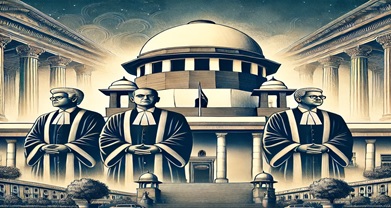Prelims: Collegium system
Mains: General Studies Paper-2, Structure, organisation and functions of the executive and the judiciary- Ministries and Departments of the Government, influential groups and formal/informal associations and their role in governance. |
Why in the NEWS?

Key Points:
- In a meeting the collegium approved the names of Justices Shailesh Pramod Brahme, Firdosh Phiroze Pooniwalla and Jitendra Shantilal Jain as permanent judges.
- It also recommended that the term of Additional High Court Judge Justice Manjusha Ajay Deshpande, should be extended for a year in the Bombay High Court.
What will you read next in this topic?
- Provision for appointment of Supreme Court and High Court judges in India
- Appointment of Judges in the Supreme Court
- Appointment of judges in the High Court
- What is the Collegium System?
- Procedure for Removal of Judges (Impeachment)
Provision for appointment of Supreme Court and High Court judges in India
- Constitutional provisions have been made for the appointment of Supreme Court and High Court judges to maintain the independence of the judiciary in India.
- The collegium system has been implemented to make the process of these appointments transparent and fair.
Appointment of Judges in the Supreme Court
Constitutional Provisions
- Article 124:
- Defines the appointment of Supreme Court judges, their qualifications, tenure and the process of removal.
- The Chief Justice of India (CJI) and other judges are appointed by the President of India.
- Article 126:
- Provides for the appointment of the Acting Chief Justice.
- If the Chief Justice is absent or his post is vacant, the senior-most judge is appointed as the Acting Chief Justice.
Appointment Process
- Appointment of Chief Justice (CJI)
- The most senior judge of the Supreme Court is appointed as the Chief Justice of India by the President.
- It has become a convention that the most senior judge is appointed as the Chief Justice, but constitutionally it is not binding.
- Appointment of other judges
- The appointment of other judges of the Supreme Court is done through the collegium system.
- The collegium consists of the Chief Justice and the four senior-most judges of the Supreme Court.
- The recommendation of the collegium is sent to the President through the Law Ministry.
- The President issues the appointment letter after approving this recommendation.
- The government can send this recommendation back once for reconsideration, but if the collegium sends the same name again, the government has to approve it.
- Qualification
- To become a judge of the Supreme Court, a person must fulfil any one of the following qualifications:
- He should be a citizen of India.
- He must have served as a judge in a High Court for at least 5 years, or
- He must have been an advocate (lawyer) in a High Court for at least 10 years, or
- He must have special knowledge and experience in legal matters in any other field which the President considers appropriate.
- Tenure and retirement
- Supreme Court judges hold office till the age of 65 years.
- Judges can be removed through the impeachment process.
Appointment of judges in the High Court
Constitutional provisions
- Article 217:
- Deals with the appointment, qualifications and tenure of judges of the High Court.
- The President appoints the Chief Justice and other judges of the High Court.
- Article 224:
- This provision deals with the appointment of additional judges.
- If the workload in a High Court is high, the President can appoint additional judges for a fixed period.
Appointment Process
- Appointment of Chief Justice
- The Chief Justice of a High Court is appointed by the President on the recommendation of the Collegium.
- The Collegium consists of the Chief Justice of the Supreme Court (CJI) and two senior-most judges.
- Usually, a senior-most judge of another High Court is appointed as the Chief Justice.
- Appointment of other Judges
- The other judges of the High Court are appointed by the President.
The following are consulted for appointment:
- The Chief Justice of the concerned High Court
- The Chief Justice and senior-most judge of the Supreme Court
- The Governor
- The State Government concerned
- Qualifications
- To become a judge of a High Court, a person must fulfil any one of the following qualifications:
- He must be a citizen of India.
- He must have practised as an advocate (lawyer) in any court for at least 10 years, or
- He must have held a judicial post for at least 10 years.
- Tenure and Retirement
- High Court judges hold office till the age of 62.
- Like Supreme Court judges, they too can be removed through the impeachment process.
What is the Collegium System?
- The Collegium System is a system implemented to maintain the independence of the judiciary in India, under which the appointment and transfer of judges of the Supreme Court and High Court are done.
Importance of Collegium System
- Ensures independence of the judiciary – This reduces the interference of the executive and the appointment of judges remains completely in the hands of the judiciary.
- Makes the judicial process transparent – Only qualified and competent judges are selected under the Collegium System.
- Protection from political influence – Due to the limited role of the government, the judiciary remains safe from political interference.
- Adherence to the principles established by the Constitution – This principle strengthens the provisions of the Independence of Judiciary given in the Constitution of India.
Who all are included in the Collegium?
- Supreme Court Collegium
- It consists of the Chief Justice of India (CJI) and four senior-most judges of the Supreme Court.
- The Supreme Court Collegium takes decisions related to the appointment and transfer of judges of the Supreme Court and High Courts.
- High Court Collegium
- It consists of the Chief Justice of the respective High Court and two senior-most judges.
- The High Court Collegium recommends the names of new judges for its court, which is approved by the Supreme Court Collegium.
How does the Collegium system work?
- The High Court Collegium first recommends names for the appointment of High Court judges.
- This recommendation is sent to the Supreme Court Collegium, which takes the final decision.
- After the approval of the Supreme Court Collegium, the names are sent to the Government (Law Ministry).
- The government seeks a report from the intelligence agencies (IB) for investigation and then sends it to the President for approval.
- If the government objects to any name, the Collegium can review it again.
- If the collegium sends the same name again, the government has to accept it.
Beginning and History of Collegium System
- Earlier, the appointment of judges was done in consultation with the President, but the tradition of limited intervention was broken in 1973.
- Subsequently, the collegium system was established through three important judicial decisions (three judge’s case) in 1981, 1993 and 1998.
- In 1993, the Supreme Court made the collegium system mandatory, and it was further strengthened in 1998.
- In 2014, the government tried to bring in the NJAC (National Judicial Appointments Commission), but in 2015 the Supreme Court declared it unconstitutional and upheld the collegium system.
Challenges of Collegium System
- Lack of transparency – No official record of the meetings and discussions of the collegium is made public.
- Conflict between the executive and the judiciary - Differences between the government and the collegium often lead to delays in appointments.
- Self-appointment system - In this, judges themselves choose other judges, due to which there have been demands for reform.
Procedure for Removal of Judges (Impeachment)
Constitutional Provisions
- The procedure for removal of a judge is given under Articles 124(4) and 217.
- To remove a judge, an impeachment motion must be passed in Parliament.
Procedure for Impeachment
- The impeachment motion is introduced in the Lok Sabha or Rajya Sabha.
- It must have the support of at least 100 MPs (Lok Sabha) or 50 MPs (Rajya Sabha) of the House.
- The inquiry is conducted by an inquiry committee of Parliament.
- If the committee finds the judge guilty, the motion is put to vote in both Houses.
- The President can remove the judge if it is passed by a two-thirds majority in both Houses.
- So far no judge in India has been removed by impeachment.
|
Q. How many judges are there in the Supreme Court Collegium?
(a) 3
(b) 5
(c) 7
(d) 9
|



